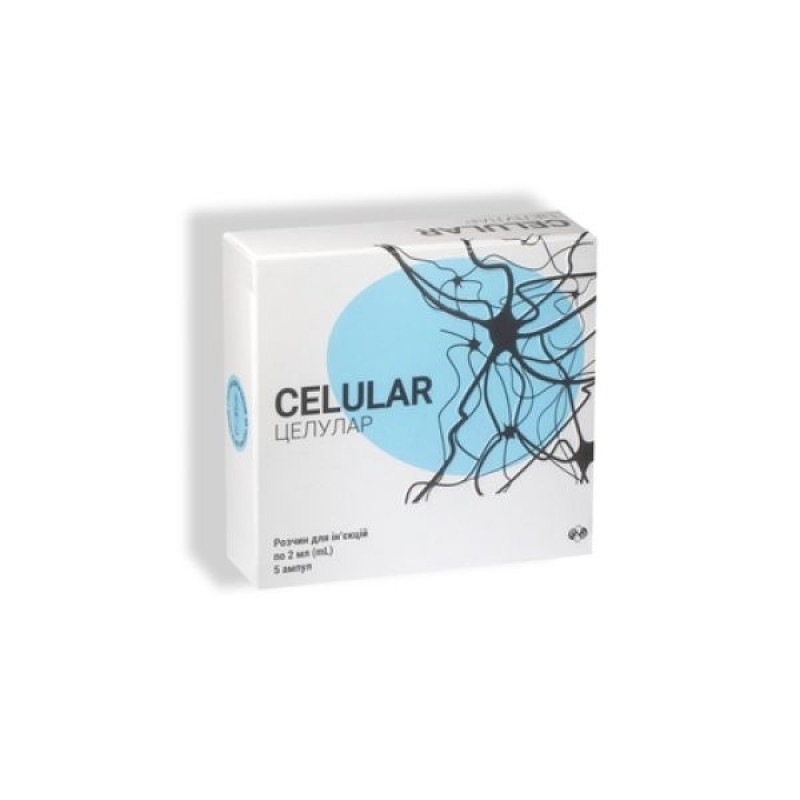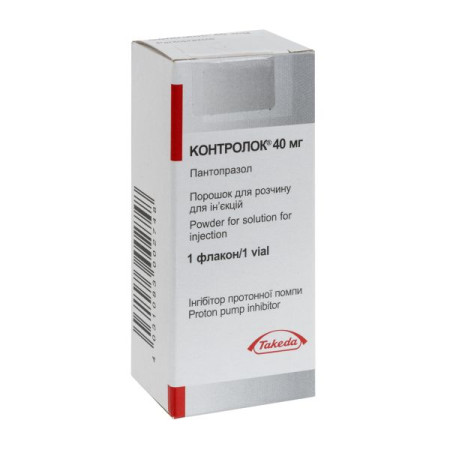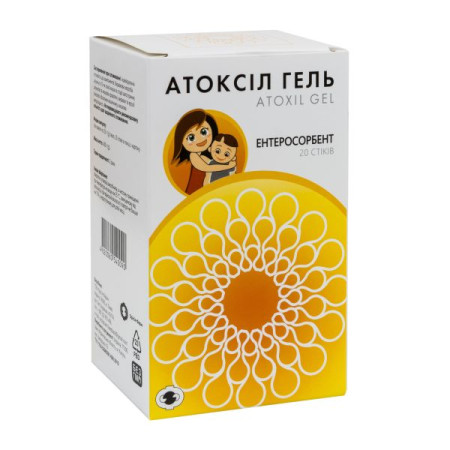Cellular solution for injection 2 ml ampoule No. 5

Instructions for use: Cellular solution for injection 2 ml ampoule No. 5
Composition
active ingredients: thiamine hydrochloride, pyridoxine hydrochloride, cyanocobalamin;
1 ml of solution contains thiamine hydrochloride (calculated as 100% substance) 50 mg, pyridoxine hydrochloride (calculated as 100% substance) 50 mg, cyanocobalamin (calculated as 100% substance) 0.5 mg;
Excipients: lidocaine hydrochloride, benzyl alcohol, sodium polyphosphate, potassium ferricyanide, sodium hydroxide, water for injection.
Dosage form
Solution for injection.
Main physicochemical properties: transparent red liquid.
Pharmacotherapeutic group
Vitamin B1 preparations in combination with vitamin B6 and/or vitamin B12. ATX code A11D B.
Pharmacological properties
Pharmacodynamics.
Neurotropic B vitamins have a beneficial effect on inflammatory and degenerative diseases of the nerves and musculoskeletal system. They should be used to eliminate deficiency states, and in large doses they have analgesic properties, help improve blood circulation, and normalize the functioning of the nervous system and the process of hematopoiesis.
Vitamin B1 is a very important active substance. In the body, vitamin B1 is phosphorylated to form biologically active thiamine diphosphate (cocarboxylase) and thiamine triphosphate (TTP).
Thiamine diphosphate as a coenzyme participates in important functions of carbohydrate metabolism, which are of crucial importance in the metabolic processes of nervous tissue, affecting the conduction of nerve impulses in synapses. With a deficiency of vitamin B1 in tissues, metabolites accumulate, primarily lactic and pyruvic acid, which leads to various pathological conditions and disorders of the nervous system.
Vitamin B6 in its phosphorylated form (pyridoxal-5'-phosphate, PALP) is a coenzyme for a number of enzymes that interact in the general non-oxidative metabolism of amino acids. Through decarboxylation, they are involved in the formation of physiologically active amines (adrenaline, histamine, serotonin, dopamine, tyramine), through transamination - in anabolic and catabolic metabolic processes (for example, glutamate-oxaloacetate transaminase, glutamatepyruvate transaminase, γ-aminobutyric acid, α-ketoglutarate transaminase), as well as in various processes of amino acid breakdown and synthesis. Vitamin B6 acts at 4 different sites of tryptophan metabolism. Within the framework of hemoglobin synthesis, vitamin B6 catalyzes the formation of α-amino-β-ketoadenic acid.
Vitamin B12 is necessary for cellular metabolism. It affects the function of hematopoiesis (extrinsic anti-anemic factor), participates in the formation of choline, methionine, creatinine, nucleic acids, and has an analgesic effect.
Pharmacokinetics.
After parenteral administration, thiamine is distributed in the body. Approximately 1 mg of thiamine is broken down daily. Metabolites are excreted in the urine. Dephosphorylation occurs in the kidneys. The biological half-life of thiamine is 0.35 hours. Thiamine does not accumulate in the body due to its limited solubility in fats.
Vitamin B6 is phosphorylated and oxidized to pyridoxal-5-phosphate. In blood plasma, pyridoxal-5-phosphate and pyridoxal are bound to albumin. The form that is transported is pyridoxal. To pass through the cell membrane, pyridoxal-5-phosphate bound to albumin is hydrolyzed by alkaline phosphatase to pyridoxal.
Vitamin B12 after parenteral administration forms transport protein complexes that are rapidly absorbed by the liver, bone marrow and other proliferative organs. Vitamin B12 enters the bile and participates in the enterohepatic circulation. Vitamin B12 crosses the placenta.
Indication
Systemic neurological diseases caused by established deficiencies of vitamins B1, B6 and B12, if they cannot be corrected by dietary nutrition.
Contraindication
Hypersensitivity to the components of the drug; acute cardiac conduction disorders; acute form of decompensated heart failure.
Vitamin B1 is contraindicated in allergic reactions.
Vitamin B6 is contraindicated for use in cases of gastric and duodenal ulcers in the acute stage (since increased acidity of gastric juice is possible).
Vitamin B12 is contraindicated for use in erythremia, erythrocytosis, and thromboembolism.
Lidocaine. Increased individual sensitivity to lidocaine or other amide local anesthetics, history of epileptiform seizures to lidocaine, severe bradycardia, severe arterial hypotension, cardiogenic shock, severe forms of chronic heart failure (grade II-III), sick sinus syndrome, Wolff-Parkinson-White syndrome, Adams-Stokes syndrome, second and third degree atrioventricular block, hypovolemia, severe liver/kidney dysfunction, porphyria, myasthenia gravis.
Pregnancy and breastfeeding.
Interaction with other medicinal products and other types of interactions
When lidocaine is administered parenterally, cardiac side effects may be enhanced by the use of adrenaline or noradrenaline. Other interactions exist with sulfonamides.
In case of overdose of local anesthetics, adrenaline and noradrenaline should not be used.
Application features
The drug contains lidocaine hydrochloride and therefore should be administered only intramuscularly. Intravenous (IV) administration into the circulatory system is not allowed. In case of accidental intravenous injection, medical supervision or observation in a hospital setting is required, depending on the severity of the symptoms. Long-term use of the drug, more than 6 months, may lead to reversible peripheral sensory neuropathy.
This medicinal product contains less than 1 mmol (23 mg) sodium per dose, i.e. essentially 'sodium-free'.
This medicinal product contains less than 1 mmol (39 mg) potassium per dose, i.e. essentially potassium-free.
This medicine contains benzyl alcohol. Benzyl alcohol is associated with a risk of serious side effects ('shortness of breath syndrome') in newborns and young children.
Due to the risk of accumulation and toxicity (metabolic acidosis), large amounts of benzyl alcohol should only be used with caution and only when absolutely necessary, especially in people with impaired liver or kidney function, and during pregnancy and breastfeeding.
Use during pregnancy or breastfeeding.
During pregnancy, the recommended daily allowance of vitamin B1 is 1.2 mg in the 2nd trimester and 1.3 mg in the 3rd trimester, and of vitamin B6, 1.9 mg from the 4th month of pregnancy. The drug can be used during pregnancy only if the patient has a confirmed deficiency of vitamins B1 and B6, since the safety of dosages exceeding the recommended daily dose has not yet been established.
During breastfeeding, the recommended daily intake of vitamin B1 is 1.3 mg, and vitamin B6 is 1.9 mg.
Vitamin B1 and B6 pass into breast milk. High doses of vitamin B6 may reduce milk supply.
The medicine contains 100 mg of vitamin B6 per ampoule, so it should not be used during pregnancy or breastfeeding.
The use of this medicinal product during pregnancy and breastfeeding should only be considered after a risk/benefit assessment by a physician.
Ability to influence the reaction rate when driving vehicles or other mechanisms. The drug does not affect the ability to drive vehicles or work with complex mechanisms.
Method of administration and doses
In severe (acute) cases, treatment should be started with 2 ml of solution intramuscularly once a day until the acute symptoms subside. To continue treatment, administer 2 ml (1 injection) 2–3 times a week.
Weekly medical monitoring is recommended during therapy.
One should strive to switch to oral therapy as early as possible.
Only intramuscular (IM) administration is permitted. Intravenous (IV) administration into the circulatory system is not permitted. In case of accidental intravenous injection, medical supervision or inpatient observation is required, depending on the severity of the symptoms.
To maintain or continue the therapeutic course of injections or to prevent relapse, it is recommended to use oral drugs of a similar pharmacotherapeutic group.
Children. The medicine should not be used in children.
Overdose
Vitamin B1 has a wide therapeutic range. Very high doses (more than 10 g) exhibit a curare-like effect, inhibiting the conduction of nerve impulses.
Vitamin B6 has very low toxicity.
Excessive use of vitamin B6 in doses exceeding 1 g per day for several months can lead to neurotoxic effects. Neuropathies with ataxia and sensory disorders, cerebral convulsions with EEG changes, and in isolated cases hypochromic anemia and seborrheic dermatitis have been described after administration of more than 2 g per day.
Vitamin B12: After parenteral administration (in rare cases, after oral administration) of doses of the drug higher than recommended, allergic reactions, eczematous skin disorders, and a benign form of acne have been observed.
With prolonged use in high doses, liver enzyme activity disorders, pain in the heart area, and hypercoagulation are possible.
Treatment: therapy is symptomatic.
Lidocaine. Symptoms: psychomotor agitation, dizziness, general weakness, decreased blood pressure, tremor, visual impairment, tonic-clonic convulsions, coma, collapse, possible atrioventricular block, central nervous system depression, respiratory arrest. The first symptoms of overdose in healthy people occur when the concentration of lidocaine in the blood exceeds 0.006 mg/kg, convulsions - at 0.01 mg/kg.
Treatment: discontinuation of the drug, oxygen therapy, anticonvulsants, vasoconstrictors (noradrenaline, mezaton), in case of bradycardia - anticholinergics (0.5–1 mg of atropine). Intubation, artificial ventilation of the lungs, resuscitation measures are possible. Dialysis is ineffective.
Side effects
The following terms are used to define the frequency of adverse reactions: very common (≥ 1/10), common (≥ 1/100 to < 1/10), uncommon (≥ 1/1,000 to < 1/100), rare (≥ 1/10,000 to < 1/1,000), very rare (< 1/10,000), not known (frequency cannot be estimated from the available data).
On the part of the immune system: unknown - benzyl alcohol may cause allergic reactions; very rarely - hypersensitivity reactions (for example: exanthema, shortness of breath, shock, angioedema).
Skin: very rarely - sweating, acne, skin reactions with itching and urticaria.
From the cardiovascular system: very rarely - tachycardia.
General condition and injection site: unknown - systemic reactions due to rapid accumulation (accidental intravenous injection, injection into tissue with high blood supply) or overdose. Dizziness, vomiting, bradycardia, cardiac arrhythmias, convulsions. Burning at the injection site.
Reporting adverse reactions after registration of a medicinal product is of great importance. This allows monitoring of the benefit/risk ratio when using this medicinal product. Medical and pharmaceutical professionals, as well as patients or their legal representatives, should report all cases of suspected adverse reactions and lack of efficacy of the medicinal product via the automated pharmacovigilance information system at the link: https://aisf.dec.gov.ua.
Expiration date
2 years.
Storage conditions
Keep out of reach of children. Store in the original packaging at a temperature of 2 °C to 8 °C.
Incompatibility
Thiamine is incompatible with oxidizing and reducing compounds: mercuric chloride, iodide, carbonate, acetate, tannic acid, ferric ammonium citrate, as well as with phenobarbital sodium, riboflavin, benzylpenicillin, glucose and metabisulfite, since it is inactivated in their presence. Copper accelerates the decomposition of thiamine; in addition, thiamine loses its effect with increasing pH values (more than 3).
Vitamin B12 is incompatible with oxidizing and reducing compounds and salts of heavy metals.
In solutions containing thiamine, vitamin B12, like other B complex factors, is rapidly destroyed by thiamine breakdown products (low concentrations of iron ions may protect against this). Riboflavin, particularly in combination with light, also has a destructive effect; nicotinamide accelerates photolysis, while antioxidants have an inhibitory effect.
Packaging
2 ml in an ampoule; 5 ampoules in a blister, 1 blister in a pack.
Vacation category
According to the recipe.
Producer
Private Joint-Stock Company "Lekhim-Kharkiv".
Location of the manufacturer and address of its place of business.
Ukraine, 61115, Kharkiv region, Kharkiv city, Severyna Pototskoho street, building 36.
There are no reviews for this product.
There are no reviews for this product, be the first to leave your review.
No questions about this product, be the first and ask your question.




